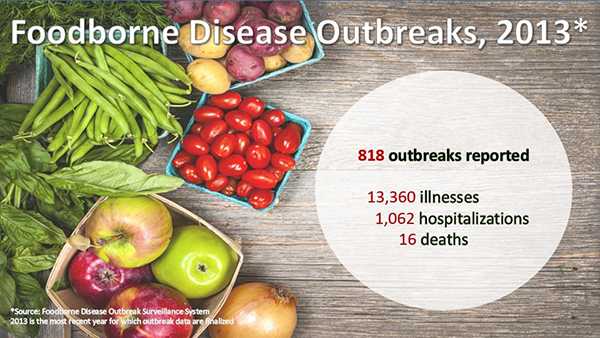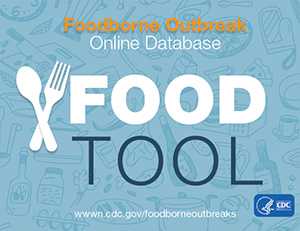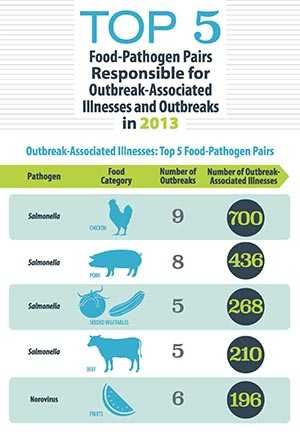Overview of Foodborne Disease Outbreaks, 2013
In May, 2015 CDC published an annual report of foodborne disease outbreaks that occurred in 2013 and updated its Foodborne Outbreak Online Database (FOOD) with data on outbreaks through 2013.
- Full reports can be found on the Food Safety FDOSS Annual Summaries of Foodborne Outbreaks web page.
Background

State and local health departments report the results of foodborne disease outbreak investigations to CDC. CDC posts annual summaries on the Food Safety FDOSS Annual Summaries of Foodborne Outbreaks web page.
- CDC also maintains a web-based platform for searching CDC’s Foodborne Disease Outbreak Surveillance System database called the Foodborne Outbreak Online Database (FOOD).
- Report of outbreaks that occurred in 2013 have now been added to that database
- The FOOD tool provides access to national information and is intended to be used for limited descriptive summaries of outbreak data.
- Please see the FOOD FAQ and Foodborne Outbreak Tracking and Reporting for more information.
- Summaries of outbreak investigations provide important snapshots of the human health impact of foodborne disease outbreaks and the agents, foods, settings, and contributing factors (for example, food not kept at the right temperature) involved in these outbreaks.
- In comparing data between years, it is important to note that changes were made to the foodborne disease outbreak surveillance system in 2009 and a new food categorization scheme was implemented in 2011.
2013 Fast Facts
Foodborne disease outbreaks
During January 1, 2013 through December 31, 2013, public health departments reported 818 foodborne disease outbreaks; these outbreaks resulted in 13,360 illnesses, 1,062 hospitalizations, and 16 deaths.
Outbreaks and Agents
- 439 outbreaks were caused by a single, confirmed agent
- The most common causes of outbreaks
- Norovirus caused 35%
- Salmonella caused 34%
Outbreak-related illnesses
- 9,359 outbreak-related illnesses were caused by a single, confirmed agent and 965 (10%) resulted in hospitalization
- The most common causes of outbreak-related illnesses
- Norovirus caused 40%
- Salmonella caused 38%
Key Data from 2013 Reports
Main Findings
818 foodborne disease outbreaks reported, resulting in:
- 13,360 illnesses
- 1,062 hospitalizations
- 16 deaths
- 14 food recalls
Agents
What agents caused the most outbreaks? 439 outbreaks were caused by a single, confirmed agent. Most commonly reported agents:
- Norovirus caused 35% of outbreaks
- Salmonella caused 34% of outbreaks
What agents caused the most outbreak-related illnesses? 9,359 outbreak-related illnesses were caused by a single, confirmed agent and 965 (10%) illnesses resulted in hospitalization
- The most common agents resulting in outbreak-related illnesses:
- Norovirus caused 40%
- Salmonella caused 38%
Germs and Foods
The pathogen-food category pairs (germs and foods) responsible for the most outbreaks and outbreak-related illnesses, hospitalizations, and deaths were
-
Outbreaks
- Scombroid toxin (histamine fish poisoning) in fish (25 outbreaks)
- Ciguatoxin in fish (15 outbreaks)
- Vibrio parahaemolyticus in mollusks (13 outbreaks)
-
Illnesses
- Salmonella in chicken (700 illnesses)
- Salmonella in pork (436 illnesses)
- Salmonella in seeded vegetables (268 illnesses)
-
Hospitalizations
- Salmonella in chicken (213 hospitalizations)
- Hepatitis A in fruits (71 hospitalizations)
- Salmonella in pork (65 hospitalizations)
-
Deaths
- Listeria in dairy (3 deaths)
Setting of Outbreaks
- 60% in a restaurant
- 14% by a caterer or at a banquet facility
- 12% at home
Multistate Outbreaks
Twenty-six multistate outbreaks were reported during 2013.
- Eleven were caused by Salmonella
- Four by Shiga toxin-producing E. coli
- Four by Listeria
- Four by Vibrio parahaemolyticus
- One by hepatitis A
- One by Cyclospora
- One by niacin
For more information about selected multistate foodborne disease outbreaks, please visit the Food Safety Foodborne Outbreaks List of Selected Multistate Foodborne Outbreak Investigations web page.
General Questions
Why is this report important?
Foodborne diseases due to known pathogens are estimated to cause about 9.4 million illnesses each year in the United States. Even though only a small proportion of these illnesses occur as part of a recognized outbreak, the data collected during outbreak investigations provide insights into the pathogens and foods that cause illness. Public health officials, regulatory agencies, and the food industry can use these data to create control strategies along the farm-to-table continuum that target specific pathogens and foods.
What else do I need to know about this year’s report?
The data from this report come from CDC’s Foodborne Disease Outbreak Surveillance System (FDOSS). State, local, and territorial health departments report the results of foodborne disease outbreak investigations to this system, and CDC provides an annual summary of outbreak investigations.
When comparing data between years, it is important to note that changes were made to this surveillance system in 2009, and a new food categorization scheme was implemented in 2011.
The findings in this report have at least three limitations. First, only a small proportion of foodborne illnesses that occur each year are identified as being associated with outbreaks. The extent to which the distribution of food vehicles and locations of preparation implicated in outbreaks reflect the same vehicles and locations as foodborne illnesses not associated with outbreaks is unknown. Similarly, not all outbreaks are identified, investigated, or reported. Second, many outbreaks had an unknown etiology (cause), an unknown food vehicle, or both, and may not be well represented by those outbreaks in which a food vehicle or etiology could be identified. Finally, CDC’s outbreak surveillance system is dynamic. Agencies can submit new reports and change or delete reports as information becomes available. Therefore, the results of this analysis might differ from those in other reports.
How can I learn how many reported outbreaks were associated with a certain food, germ, or setting?

Foodborne Outbreak Online Database (FOOD Tool) is a web-based program you can use to search CDC’s Foodborne Disease Outbreak Surveillance System database. FOOD Tool lets users search foodborne disease data by year, state, food and ingredient, location where food was prepared, and cause. It provides information on numbers of illnesses, hospitalizations, deaths, the germ, and the confirmed or suspected cause.
For guidance on using the data and limitations to keep in mind when searching by food or ingredient, take a look at frequently asked questions about FOOD Tool.
How can I find out about foodborne disease outbreak trends?
Surveillance for Foodborne Disease Outbreaks – United States, 1998-2008 describes 11 years of data about the causes of outbreaks and where they occur; the pathogens and foods that caused the most outbreaks, illnesses, hospitalizations, and deaths; and trends in the pathogens and foods associated with outbreaks over time. Learn more >
What factors influence outbreak investigation and reporting?
Although foodborne disease outbreaks are a nationally notifiable condition, many factors can influence outbreak investigation and reporting, including available resources (such as time, staff, and laboratory capacity), health department priorities, and the characteristics of an outbreak (such as its size and severity).
Why is the cause of so many reported outbreaks unknown?
Even well-conducted investigations may not be able to identify the cause of an outbreak. Several factors influence whether investigators can identify the cause of an outbreak, including the timing of when a specimen is obtained.
- Infections are often diagnosed using specific laboratory tests that can identify bacteria, chemical agents and toxins, parasites, and viruses. When an outbreak isn’t identified until after the optimal time to obtain specimens from ill people, it may not be possible to obtain specimens for laboratory analysis or the laboratory tests may be negative.
- When timely specimens are obtained, other factors can lead to the cause not being detected. For example, clinical laboratories may not have the resources needed to identify some germs. In these outbreaks, the state public health laboratory or CDC may perform additional tests to try to identify the germ.
Even if the cause is not identified, CDC encourages states to report all foodborne disease outbreak investigations.
Why is the food unknown for so many reported outbreaks?
Even the most thorough investigations can fail to identify the contaminated food under certain circumstances, such as when most of the people who became sick ate many of the same foods (making it hard to identify the one that caused them to become ill), the number of people ill is very small, or the outbreak is identified after people’s memories of what they ate before getting sick have faded. CDC encourages health departments to report all foodborne outbreak investigations. Even if the contaminated food is not determined, we can learn useful information that can help shape prevention efforts.
More Information
- Full Surveillance Reports
- Foodborne Outbreak Online Database (FOOD): Individual outbreak data including etiology, locations, and food vehicles through current year
- Foodborne disease outbreak investigations and surveillance data from previous years
- CDC and the Food Safety Modernization Act
- The National Outbreak Reporting System (NORS): Resources on reporting foodborne disease outbreaks for state and local health departments:
- Page last reviewed: August 20, 2015
- Page last updated: January 28, 2016
- Content source:


 ShareCompartir
ShareCompartir
